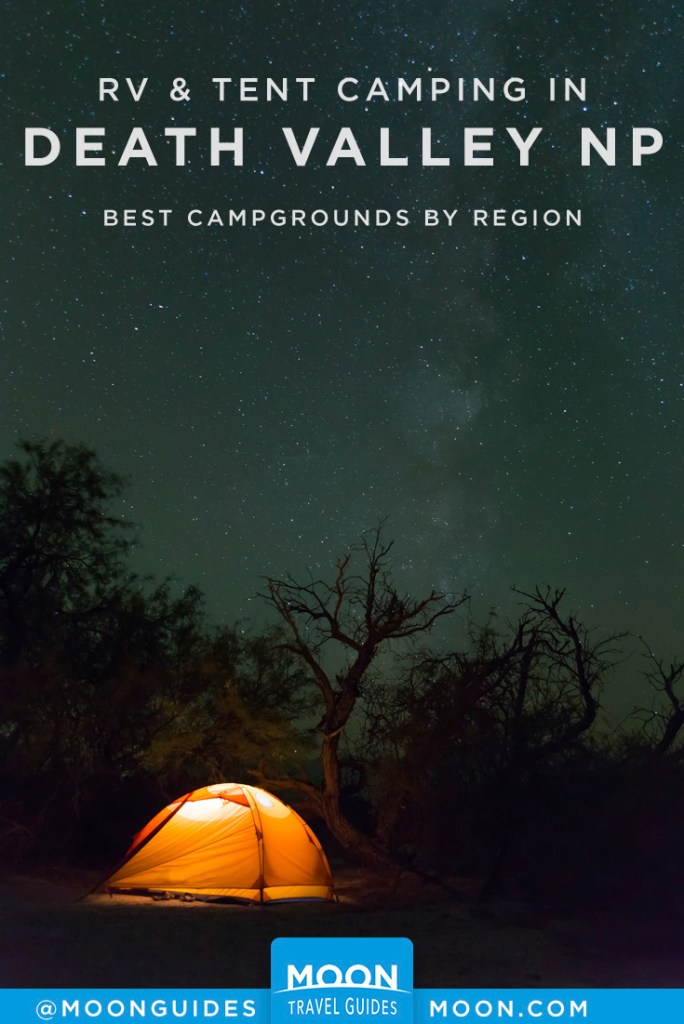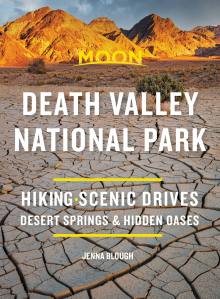Death Valley Campgrounds for Tents and RVs
There are 12 campgrounds in Death Valley National Park. With the exception of Furnace Creek Campground (which accepts reservations October 15 to April 15) and Fiddlers’ Campground (which accepts reservations year-round), all other Death Valley campgrounds are first-come, first-served. Finding an open site is rarely a problem; however, Texas Spring Campground in Furnace Creek may fill during spring weekends. High elevation campgrounds can fill during holiday weekends in summer.
Campgrounds are open seasonally (either fall-spring or spring-fall) depending on their elevation. Check the National Park Service website for seasonal alerts prior to heading out on a Death Valley camping trip. There are also primitive campgrounds and many opportunities for backcountry camping.
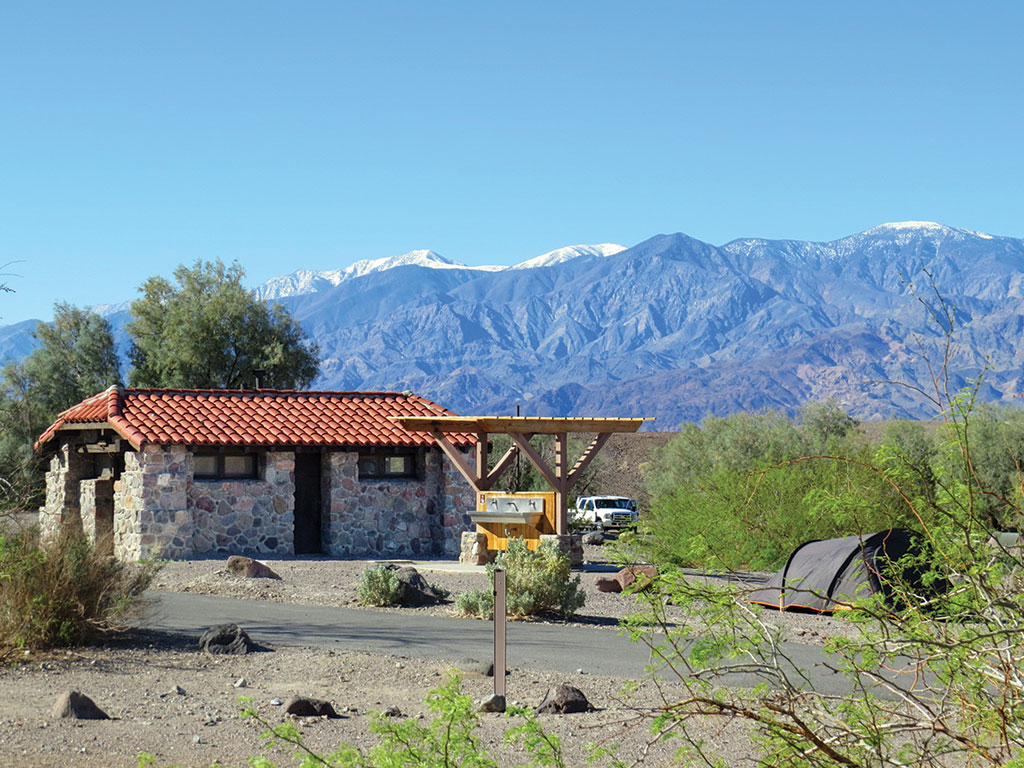
Furnace Creek Campgrounds
There are four campgrounds clustered around Furnace Creek, all with their pros and cons. Furnace Creek Campground is the only campground open in summer. Texas Spring and Sunset Campgrounds are open October 15 to April 15. Furnace Creek and Sunset Campgrounds both sit at 196 feet below sea level, making them oppressively hot in summer, and Texas Spring, at sea level, is not much higher or cooler. Site passes for Sunset and Texas Spring are sold at automated kiosks that take major credit cards and cash. Passes are for general overnight admission but do not specify sites.
Summer at Furnace Creek can create its own kind of ghost town due to the excessive heat at lower elevations. If you are planning to camp in Death Valley in summer, you would be wise to camp at higher elevations in other sections of the park.
Tip: All campgrounds can get very windy at night regardless of the time of year or the temperature. If you are tent camping, make sure you have your tent properly staked, and make sure everything that could be blown away is secured (camp chairs love to catch air when you’re not watching). If you’re relying on RV electric hookups, don’t be surprised by electricity surges.
Fiddlers’ Campground
Located at the Ranch at Death Valley, the privately run Fiddlers’ Campground (760/786-2345 or 800/236-7916, www.oasisdeathvalley.com, $24) offers RV sites (no hook-ups, back-in only). One tent is allowed per site. While not the place for those seeking desert solitude, it does include amenities such as wireless Internet and access to Ranch at Death Valley’s pool, showers, and sports facilities. Communal picnic tables and fire pits are available within the campground but not at individual sites. Sites can be reserved year-round through Oasis at Death Valley.
Furnace Creek Campground
The Furnace Creek Campground (877/444-6777, year-round, $22, $36 with hook-ups) is an RV and tent campground with 136 sites. It’s the only public campground that takes reservations (Oct. 15-Apr. 15) in Death Valley, so for busy weekends in spring or on holidays, or for travelers who like to have a set itinerary, this is a good option. From mid-April to mid-October, sites are first-come, first-served; reservations are not accepted. The campground is right next to the Ranch, so while it’s easy to walk to dining and amenities, it also means this is not the serene desert escape you might be looking for. The surrounding valley and hills provide a beautiful setting, but the campground itself can be crowded and disorderly. There are some walk-in tent sites, which afford slightly more serenity. Day passes ($10) are available for the Ranch pool and showers. This might be a selling point if you’re staying for several days or are visiting in the hotter parts of the year.

Sunset Campground
Sunset Campground (first-come, first-served, Oct. 15-Apr. 15, $12) is across the road from Furnace Creek Campground and conveniently located near the services at Furnace Creek Ranch. With 270 sites, it caters mainly to RVs and is peaceful but spare, meaning it is basically a very scenically located parking lot. Amenities include water, flush toilets, and a dump station. It’s useful as an overflow if Furnace Creek Campground is full or to avoid some of the congestion there.
Texas Spring Campground
Texas Spring (first-come, first-served, Oct. 15-Apr. 15, $16) shares an entrance with Sunset Campground, but it is a little more scenic, tucked farther into the hills with tamarisks offering shade at a few of the sites. This also means that it is the most popular campground in the area, and its 92 tent and RV sites fill up quickly. Amenities include water, picnic tables, fire pits, flush toilets, and a dump station.
Backcountry Camping in Furnace Creek
The Furnace Creek region has the most restrictions on where backcountry camping is allowed. Camping is not allowed on the valley floor from Ashford Mill in the south to two miles north of Stovepipe Wells. Camping is also not allowed directly off the West Side Road, but it is permitted along some of the Panamint Mountain canyon roads that are accessed by the West Side Road. To camp off the canyon roads, such as Johnson and Hanaupah Canyons, you must drive at least two miles in along any of the canyon roads from the West Side Road. (Pay attention to any posted signs, as the two-mile mark is a general rule of thumb, and some canyon roads may require you to go farther from the West Side Road.)
Backcountry sites are unmarked and have no amenities; look for spots that are flat, have easy turnouts, or look like they have been camped in before. The roads in this area become increasingly rough farther toward the canyon; if you’re driving a basic, high-clearance vehicle, such as a city SUV, you might not want to venture much past the two-mile mark. If you do snag one of these canyon spots, they can be austere and quiet with views of Badwater Basin glowing in the distance; however, they can be very windy, especially at night.
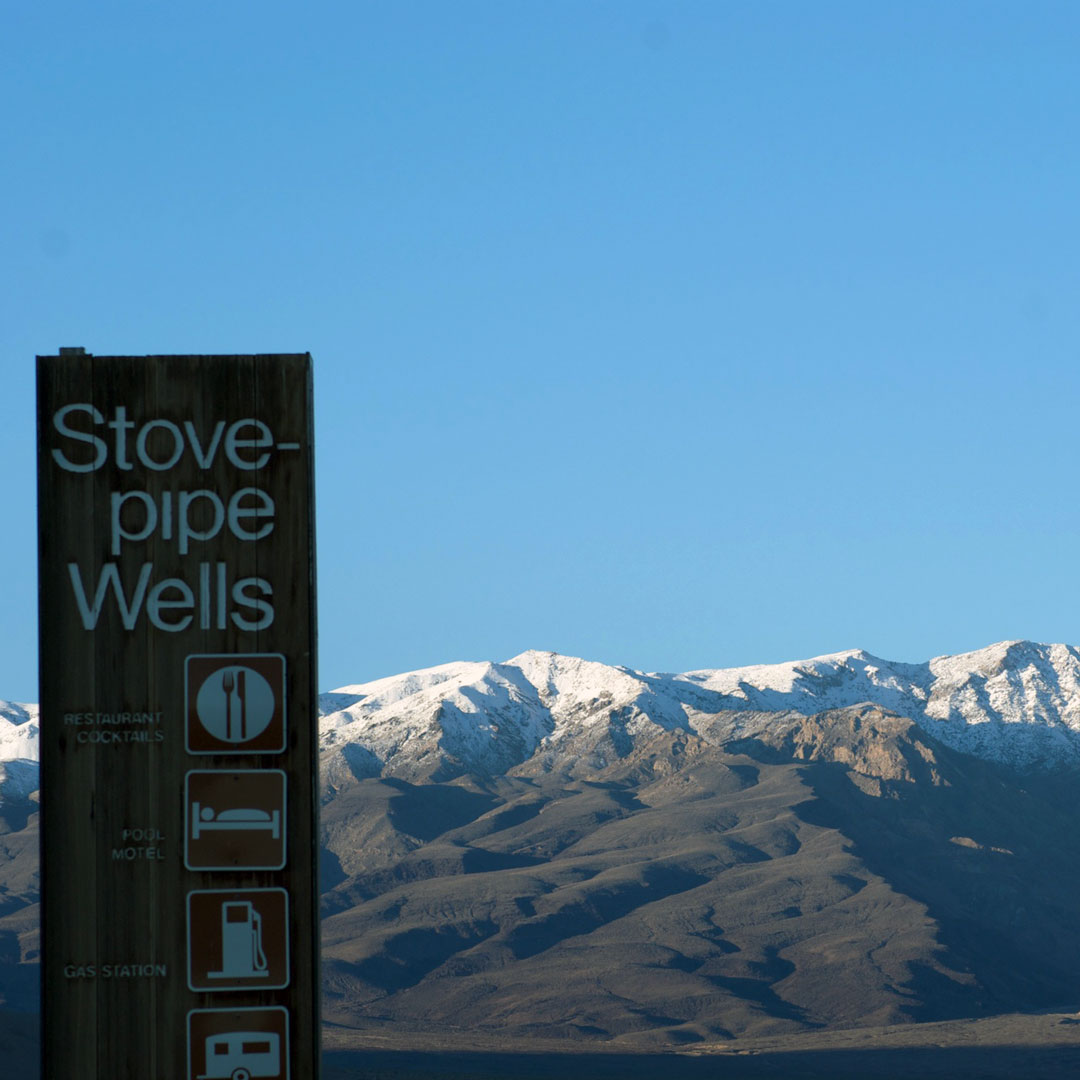
Stovepipe Wells Campgrounds
The campground at Stovepipe Wells (190 sites, first-come, first-served, mid-Sept.-early May, $14) has basic tent sites and RV sites without hookups. This is a central location for exploring a big swath of Death Valley. Beyond the prime location, the campground mostly resembles a parking lot, although the surrounding desert and Cottonwood Mountains are lovely in their austerity. The campground sits right at sea level, and the sites are completely exposed, which means it can be blazingly hot, and there is no privacy. Prepare to become friends with your neighbors. Amenities include picnic tables, potable water, and flush toilets. There is access to the Stovepipe Wells Hotel pool and showers ($4 per day).
Stovepipe Wells RV Park (14 sites, year-round, $40, full hook-ups) shares space with the Stovepipe Wells campground; sites are located next to the General Store. RV fees include access to the swimming pool and to Wi-Fi in the hotel lobby.
Backcountry Camping in Stovepipe Wells
If you’re adventurous and prepared, backcountry camping might be a better and certainly more scenic option than the developed campground at Stovepipe Wells.
Backcountry camping is not allowed off Titus Canyon Road, Mosaic Canyon Road, Grotto Canyon Road, the first eight miles of Cottonwood Canyon Road, or on the valley floor from two miles north of Stovepipe Wells down to Ashford Mill in the Furnace Creek region. This list limits your options since it covers most of the roads that enter the region’s mountains and scenic bypasses.
Cottonwood Canyon makes a fine camp, as long as you camp beyond the first eight miles; it is scenic and has a water source. Chloride City, in the Nevada Triangle area, offers backcountry options in a scoured landscape with the Funeral Mountains as the backdrop. You’ll have no problem finding a place all to yourself out here.
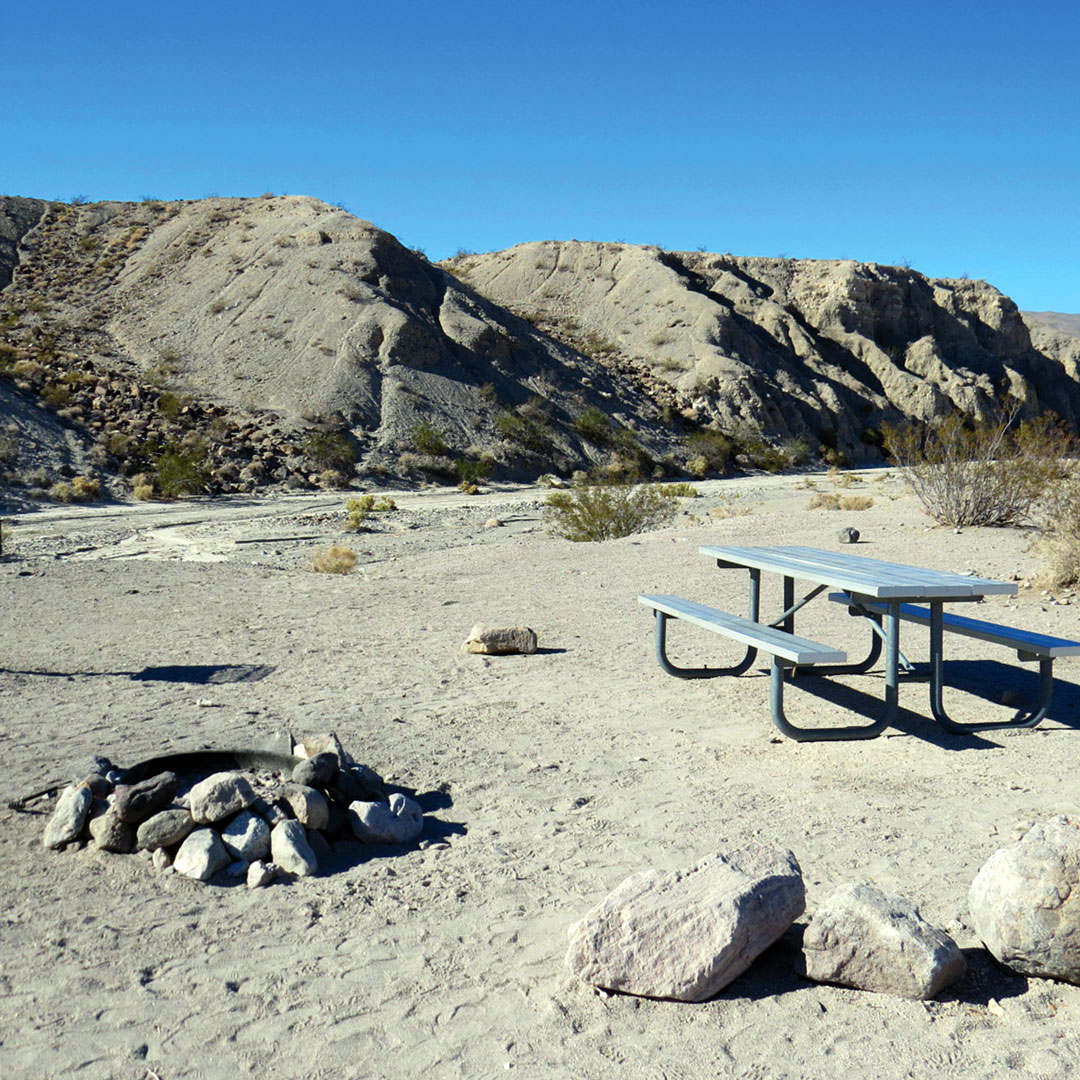
Scotty’s Castle and Eureka Valley Campgrounds
There are no services in the Eureka Valley region—no hotels, restaurants, or gas. The park hubs of Stovepipe Wells and Furnace Creek are one to three hours’ drive south, and the closest services are in Big Pine, about 50 miles (two hours) west. Bring your own food and water, make sure you have enough gas, and be prepared to camp.
Mesquite Spring Campgrounds
Mesquite Spring (30 sites, first-come, first-served, year-round, $14) is the only developed campground in the region. It’s a pretty campground, dotted with mesquite bushes and set along low hills less than five miles west from Scotty’s Castle. At an elevation of 1,800 feet, the temperature is bearable most of the year, except summer. Sites are exposed, but spaced far enough apart that you get some privacy. Though reservations aren’t accepted, it’s very likely you’ll get a spot May-Oct. Since this is one of the few campgrounds open year-round, the campground can fill on summer holiday weekends. Stop to reserve a spot first thing in the morning; pay via an automated kiosk, which takes credit cards and cash, and put your receipt on the site marker. Amenities include picnic tables, fire pits, and access to flush toilets and water; there are no RV hookups, but there is a dump station.
Directions
The turnoff to Mesquite Spring is located 0.6 mile south of the intersection of Scotty’s Castle Road and Highway 190; from the turnoff, continue 1.9 miles south to the campground.
Newsletter Signup
By clicking ‘Sign Up,’ I acknowledge that I have read and agree to Hachette Book Group’s Privacy Policy and Terms of Use
Eureka Dunes Dry Camp
Eureka Dunes Dry Camp (first-come, first-served, free) is a small, primitive maintained campground. A stay here puts you within easy distance of the remote Eureka Dunes. Sites have fire pits and sturdy cement picnic tables; there is no water and no electric hookups, but there is a pit toilet. If all the sites are full, there are backcountry camping spaces just beyond the campground off Eureka Road. The only thing that distinguishes them from the official campsites is their lack of a picnic table and a fire pit.
Directions
To get here from the intersection of Scotty’s Castle Road and Highway 190, head north for 2.8 miles and continue on Big Pine-Death Valley Road for 21.8 miles. At Crankshaft Crossing, marked by a sign and rusted crankshafts, turn left (southwest) to stay on Big Pine-Death Valley Road. The turnoff to Eureka Dry Camp is 12.2 miles farther. Turn left onto the South Eureka Road and drive 9.6 miles to the campground at the base of the dunes. Big Pine-Death Valley Road, as well as Eureka Dunes Road, are graded dirt roads usually suitable for passenger cars and good enough to bring a camper or RV to this spot.
Homestake Dry Camp
In Racetrack Valley, your best bet is Homestake Dry Camp (first-come, first-served, free), a primitive maintained campground. Four camp spaces have been graded so that you can comfortably park and pitch a tent. In the highly unlikely event that these sites are full, simply set up camp nearby. The only amenity is one decrepit pit toilet, and there are no fire pits provided, so fires are not permitted. Bring your own water. Despite the lack of amenities, the campground serves as a good base to explore the surrounding area—Ubehebe Peak, the Racetrack, Lippincott Mine, Ubehebe Lead Mine, and Corridor Canyon.
Directions
To reach Homestake Dry Camp, access the Racetrack Valley Road from where it leaves paved Highway 190 and drive 19.4 miles south to Teakettle Junction. Continue south on the Racetrack Valley Road for eight miles to the southern end of the Racetrack playa. Continue two miles south beyond the playa, a total of 29.4 miles from Highway 190, to a small campground sign and the graded camping spaces that mark Homestake Dry Camp.
Backcountry Camping near Scotty’s Castle and Eureka Valley
Only a few roads traverse this region, so it’s important to know where backcountry car camping is allowed. The main dirt road, Racetrack Valley Road, is tempting, but there is no camping between Teakettle Junction and Homestake Dry Camp.
Instead, consider turning left at Teakettle Junction and heading south along Hidden Valley Road toward Hunter Mountain. The road is passable in a high-clearance vehicle for 13 miles to the area around Goldbelt Spring, at the base of Hunter Mountain. Beyond Goldbelt Spring, the road becomes 4WD-only as it climbs Hunter Mountain.
If you plan to rock-climb or explore the Cottonwood Mountain Canyons, camp in the vicinity of White Top Mountain. White Top Mountain Road is located off Hidden Valley Road; take the left turn at the junction 3.2 miles south of Teakettle Junction. The road begins as passable for high-clearance vehicles, then requires a 4WD vehicle after about five miles. There is no camping allowed at the Ubehebe Mine or the Lost Burro Mine.
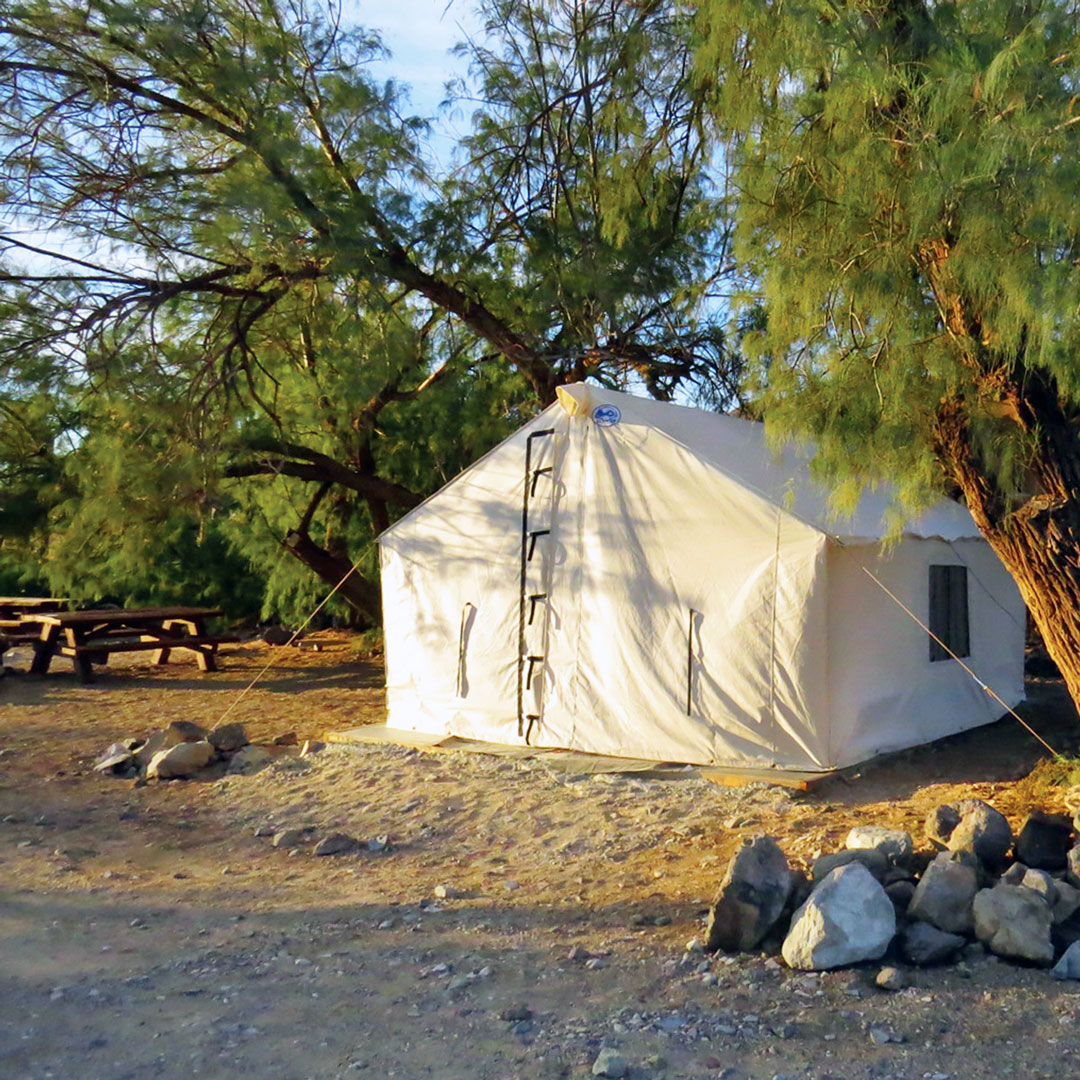
Panamint Springs and Saline Valley Campgrounds
Panamint Springs Resort
The Panamint Springs Resort Campground (40440 Hwy. 190, 775/482-7680, 8am-8pm daily year-round, $10-75) has a total of 76 accommodations, including tent cabins (1-5 people, $50-75), RV sites (30- and 50-amp hookups, $20-40), tent sites (1 tent, 1 vehicle, $10), and one group site. All sites have fire pits; most have picnic tables. Amenities include drinking water and flush toilets. Best of all, they have hot showers (free with a site, fee for non-guests), a rarity in Death Valley campgrounds (Furnace Creek, the crowded hub on the other side of the park, is the only other campground with showers). The campsites can fill quickly, so make reservations well ahead of time. There is a surcharge of $5 for pets in RV and tent sites.
Emigrant Campgrounds
Emigrant Campground (10 sites, first-come, first-served, year-round, free) is a tiny tent-only campground located at the junction of Highway 190 and Emigrant Canyon Road. It’s a pretty spot that more closely resembles a day-use area. Sites are small, close together, and exposed to the open desert. It’s too small to serve as a base camp for several days, but it will do in a pinch. At 2,100 feet elevation and with no shade, it can be uncomfortably hot in summer, although cooler than the valley floor (but almost any place is cooler than the valley floor). Amenities include picnic tables, drinking water, and restrooms with flush toilets.
Directions
Emigrant is located directly off paved Highway 190, approximately 21 miles east of Panamint Springs, so it’s easy to access and centrally located.
Wildrose Campgrounds
Cheerful and sunny Wildrose Campground (23 sites, first-come, first-served, year-round, free) is tucked away at the lower end of Wildrose Canyon. At 4,100 feet elevation, the camp sits at a good mid-level point to avoid the scorching temperatures of the valley floor in summer and the snow of the higher elevations. Unlike the seasonal campgrounds located at the higher elevations of the canyon, Wildrose is open year-round and rarely fills up. Its level sites don’t offer privacy or shade, but it’s a peaceful campground in a quiet and lovely section of the park. It’s a great place to set up a base camp for exploring the Emigrant and Wildrose Canyon areas, with easy access to Skidoo, the Charcoal Kilns, Wildrose Peak, and Telescope Peak. Amenities include picnic tables, fire pits, potable water, and pit toilets; the campground is also accessible to small trailers.
Directions
To get here from the north, take Emigrant Canyon Road south toward Wildrose Canyon from Highway 190 for approximately 21 miles, to the end of Emigrant Canyon Road. From the south, Trona Wildrose Road veers past it approximately 46 miles north of Trona. Trona Wildrose Road is prone to washouts, and the road was closed for most of 2014. Pay attention to park alerts, and check for road closures before planning your route.

Thorndike Campgrounds
Rocky and remote Thorndike Campground (6 sites, first-come, first-served, Mar.-Nov., free) is perched between the canyon walls high up in Wildrose Canyon. This campground lies between Wildrose Campground, downcanyon, and Mahogany Flat, at the top of the canyon, which means it can get overlooked. Since it’s lightly visited, you should have no problem getting a spot; you might even have it all to yourself. The combination of steep canyon walls, a perch off the winding canyon road, and winds whipping downcanyon through gnarled juniper trees gives this place a wild and forgotten feel. However, the sheerness of the canyon walls cuts in on the daylight hours, so when the sun dips, it can get chilly. Bring firewood, as the nights can get surprisingly cold, even in summer. However, this can be a welcome relief when it’s too hot at lower elevations.
Almost all campsites are shaded—a rarity in Death Valley. Amenities include picnic tables, fire pits, and pit toilets; there is no drinking water available (the closest drinking water is at Wildrose Campground, about eight miles downcanyon). If you want to hike both Telescope Peak and Wildrose Peak, this is a great home base.
At 7,400 feet elevation, snow can make access impossible to vehicles from November to March.
Directions
To get here from the north, take Emigrant Canyon Road south toward Wildrose Canyon from Highway 190 for approximately 21 miles, to the end of Emigrant Canyon Road at Wildrose Campground. At Wildrose Campground, take Wildrose Canyon Road another nine miles up the canyon. The pavement ends at seven miles, at the Charcoal Kilns. The gravel road is steep and rocky from here. A high-clearance vehicle is necessary; a 4WD vehicle is preferable when navigating snow, ice, or washouts. The road is not accessible to trailers. From the south, drive Trona Wildrose Road 46 miles north of Trona to the Wildrose Campground, and then drive an additional nine miles up Wildrose Canyon Road. Keep in mind that Trona Wildrose Road is prone to washouts. If the road is closed, you might have to bypass it.
Mahogany Flat Campgrounds
Perched at the top of Wildrose Canyon, Mahogany Flat Campground (10 sites, first-come, first-served, Mar.-Nov., free) offers cool temperatures, sweeping views, and access to Telescope Peak, the highest mountain peak in the park. At 8,200 feet elevation, expect cool nights, which can be a lifesaver in the summer. Many people use this campground as a jumping-off point to hike Telescope Peak, since the trailhead starts just outside the campground. It gets some traffic because of the popularity of Telescope Peak, but you are still likely to find a spot.
Amenities include picnic tables, fire pits, and pit toilets; there is no drinking water available (the closest water is at Wildrose Campground, about nine miles down canyon). Snow may make the campground inaccessible November through March.
Directions
To get here from the north, take Emigrant Canyon Road south toward Wildrose Canyon from Highway 190 for approximately 21 miles, to the end of Emigrant Canyon Road at Wildrose Campground. At Wildrose Campground, take Wildrose Canyon Road another 11 miles up the canyon to the end of the road at the campground. The road gets slightly steeper and rockier past Thorndike Campground. A high-clearance vehicle is necessary; a 4WD vehicle is better when navigating snow, ice, or washouts. From the south, drive Trona Wildrose Road 46 miles north of Trona to Wildrose Campground, and then drive an additional 11 miles up the Wildrose Canyon Road until it ends at the campground.

Backcountry Camping in Panamint Springs and Saline Valley
Depending on where you go, backcountry camping could be your only option—or your best option.
In the Emigrant Canyon and Wildrose Canyon areas, developed campgrounds are the best bet; the most tempting backcountry choices here are off-limits. Backcountry camping is not allowed off Skidoo Road, Wildrose Canyon Road, or Aguereberry Point Road. These are all considered day-use only roads and are some of the only roads in the area.
Western Panamint Canyons Campgrounds
When exploring the western Panamint Canyons, backcountry camping is the only choice, unless you commute from Panamint Springs or Wildrose Canyon for day explorations only. Of course, this limits your fun. The Western Canyons, including Surprise Canyon and Jail Canyon, are popular backpacking and 4WD trails. Many of these canyons begin on Bureau of Land Management (BLM) land and cross into the jurisdiction of Death Valley National Park. When camping on BLM land, or for any backcountry camping, camp in a site that has already been disturbed (sometimes called a dispersed site or dispersed camping). To locate dispersed sites, look for pullouts or spurs off the road that are hard-packed and devoid of vegetation. These are not labeled as campsites, but if you know what to look for, you can have an enjoyable backcountry experience.
If you want to set up a main base camp or give yourself a fresh start for backpacking or exploring the 4WD trails in the canyons, the ghost town of Ballarat is a good place to start. There are no supplies aside from the cold soda and beer in the caretaker’s icebox, but you will be strategically located to get your fill of old mining camps, rocky creeks, and sculpted canyon walls.
Saline Valley Campgrounds
Saline Valley Warm Springs has semideveloped camping spots. These sites are used primarily by people visiting the springs. There are well-maintained pit toilets and outdoor shower stations with water piped from the hot springs. There are no fees for camping, and drinking water is not available. From Saline Valley Road, the primitive 6.8-mile road to the camp can be sandy and hard to follow.

Newsletter Signup
By clicking ‘Sign Up,’ I acknowledge that I have read and agree to Hachette Book Group’s Privacy Policy and Terms of Use
Pin it for Later
